FY2010 Junior researchers research initiatives :TAKEDA Toshiyuki
|
Title: Arabicization of Scientific and Technical Terms in the Age of Globalization |
>>E |
FY2010 Junior researchers research initiatives :MORI Takuro
|
Title: Investigation of bio-deteriorating damage to wooden house in Indonesia |
>>E |
Research Theme for the G-COE Program: SATO, Shiro
I have a special interest in re-examining non-Western International Relations (IR). I would like to explore a new paradigm of “sustainable humanosphere” with this IR approach in our G-COE Program. The methodology and epistemology of IR are mainly based on Western values, ethics, law, history, and so on. Western IR theories are often unable to account for affairs and phenomena in Asia and Africa. In recent years, there has been a renewed interest in theories of IR in the Asia-Pacific region. Amitav Acharya and Barry Buzan provocatively questioned the reason for the absence of a non-Western IR theory. IR scholars in Asia have recently attempted to propound Asian IR theories such as Chinese IR or Japanese IR with an eye to the “English School.” The aim of my research is to reconsider the methodology and epistemology of IR theories from Asian and African perspectives. In this context, I put forth a theory of “Global Area Studies” or “Regional International Relations (i.e., Non-Western IR).”
FY2009 Junior researchers research initiatives :KAIDA Rumi
|
Title: Tree breeding for sustainable industrial forests |
>>E |
FY2009 Junior researchers research initiatives :YAMANE Yusuke
|
Title: Studies on tornadoes and severe local storms in the |
>>E |
FY2009 Junior researchers research initiatives :Haris Gunawan
|
Title: The Ecological Characteristic of Peatland Ecosystem in Giam Siak Kecil –Bukit Batu Biosphere Reserve, in Riau Province, Sumatra, Indonesia |
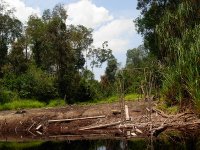 |
>>E |
FY2008 Junior researchers research initiatives : TABATA Yoshikazu
| Title:Charasteristics of Diurnal Variation in Indonesian Maritime Continent Place of Fieldwork: Indonesia |
>>PDF |
FY2008 Junior researchers research initiatives : WADA Taizo
| Title:Preference of end of life care --Comparative study of Thai and Japanese elderly— Joint Researcher:Yasuko Ishimoto、Yoriko Kasahara、Yumi Kimura、Mayumi Hirosaki |
>>PDF |
FY2008 Junior researchers research initiatives : FUJITA Motoko
| Title:Bird diversity in Acacia mangium plantations and its effect on nutrient cycling Place of Fieldwork: Indonesia |
>>PDF |
FY2008 Junior researchers research initiatives : KAIDA Rumi
| Title:Tree breeding for sustainable industrial forests Place of Fieldwork: Indonesia |
>>PDF |
FY2007 Junior researchers research initiatives : ITO Masayuki
| Title:Study on GHG dynamics in a tropical forest ecosystem using stable isotope measurements Place of Fieldwork: Malaysia,Indonesia |
>>PDF |
Training Program for young G-COE scholar : UBUKATA, Fumikazu
| Organization: Development Studies Institute(DESTIN),The London School of Economics and Political Science Country: United Kingdom Facilitator: Dr. Tim Forsyth (Reader in Environment and Development, DESTIN) Duration: 15th of September, 2008 – 16th of February, 2009 (155days) |
| Introduction of Dispatched Institution:November, 2008 Here, I will introduce the Development Studies Institute (DESTIN) of the London School of Economics (LSE), to which I am ・・・detail>> |
 |
FY2007 Junior researchers research initiatives : FUJITA, Motoko
| Title:Evaluation of bird biodiversity with special references to avian contribution to nutrient cycling in Acacia plantation forests Place of Fieldwork: Sumatra, Indonesia Joint Researcher: Dewi Prawiradilaga/HAYASHI, Takahisa/YANO, Hiroyuki/YOSHIMURA, Tsuyoshi |
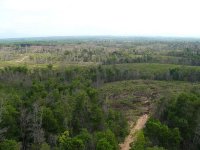 |
>>PDF |
FY2007 Junior researchers research initiatives : UBUKATA, Fumikazu
| Title:Livelihoods and worldviews of the Javanese immigrants: A view from “Pekarangan” Place of Fieldwork: Indonesia Joint Researcher: Retno Kusumaningtyas, Tetsuya Shimamura |
FY2007 Junior researchers research initiatives : SATO, Takahiro
| Title:Present condition of bioenergy use and related institutional introduction in Mainland Southeast Asia Place of Fieldwork: Vietnam,Cambodia, Laos,Thailand, Myanmar |
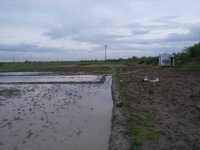 |
FY2007 Junior researchers research initiatives : NAKAMURA, Kyoko
| Title:Construction of Self and Others in the East African Pastoralists’ Societies: Flexibility and Plurality of Identities Place of Fieldwork: Kenya Joint Researcher: NAITO, Naoki |
 |
>>PDF |
FY2007 Junior researchers research initiatives : KITAMURA, Yumi
| Title:Religion as Humanosphere: The Religion of Chinese Indonesians in a “Secular” Islamic State Place of Fieldwork: Indonesia |
 |
>>PDF |
FY2007 Junior researchers research initiatives : NISHI, Makoto
| Title:Virus, democracy and sustainable society: the experience of community-based HIV/AIDS programs among the Gurage, southern Ethiopia Place of Fieldwork: Ethiopia |
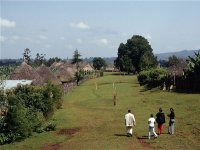 |
>>PDF |
FY2007 Junior researchers research initiatives : Kazato Mari
| Title:What are the Cultural Values of Precious Metals in Rural and Urban Mongolia Today, Especially those of Silver Goods? Place of Fieldwork: Mongolia |
 |
>>PDF |
FY2007 Junior researchers research initiatives : HOSODA Naomi
| Title:Perspectives from Hyper Mobile Societies: Towards Sustainable Humanosphere Paradigm Place of Fieldwork: Philippines Joint Researcher: ISHIBASHI, Makoto/KOBARI, Yoshihiro/ZAYAS, Cynthia Neri/CASTRO, Nestor T./WATANABE, Akiko |
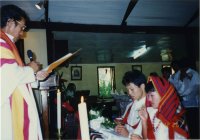 |
>>PDF |
FY2007 Junior researchers research initiatives : SATO Yasuaki
| Title:Changing Process of Local Knowledge on Genetic Resources of Banana-family Crops, Banana (Musa spp.) and Enset (Ensete Ventricosum) in East Africa Place of Fieldwork: Sidama zone, Southern Nations, Nationalities, and People's Region, Ethiopia |
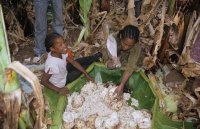 |
FY2007 Junior researchers research initiatives : KAIDA Rumi
| Title:Tree breeding for sustainable industrial forests Place of Fieldwork:Indonesia Joint Researcher: UBUKATA, Fumikazu/KAKU, Tomomi/Enny Sundarmonowati |
>>PDF |
FY2007 Junior researchers research initiatives : ADACHI Toru
| Title:Monitoring of the lightning activity in Southeast Asia Place of Fieldwork: Padang, West Sumatra, Indonesia |
>>PDF |
FY2007 Junior researchers research initiatives : FURUICHI Takahisa
| Title:Land and water management in Southeast Asia for the sustainability of the society; An analysis of change in land-use and its integration into land and water management Place of Fieldwork: Myanmar |
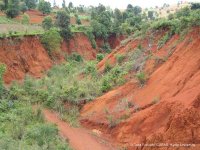 |
>>PDF |
Research Theme for the G-COE Program: KOZAN, Osamu
Estimating the impacts of climate change and human activity on regional hydrological cycle in the Aral Sea Basin
Overcoming regional water problems requires an understanding of both natural hydrological conditions and social and historical changes in regional water policy. Central Asian nations face serious water problems, and here we review the circumstances surrounding water resources in the Syr Darya and Amu Darya River basins in terms of water management changes and climatic trends. Two major rivers – the Syr Darya and the Amu Darya – originally flowed into the Aral Sea, once an inland lake that was the world’s fourth largest in water area. In the 1960s, the Soviet Union started large-scale irrigation projects in the vast dry steppes extending through the mid and downstream basins of these two rivers. Irrigated land grew from about 4.5million hectares (ha) in 1960 to about 7 million ha in 1980.
During these two decades, the population almost doubled from 14 million to 27 million, as did the amount of water taken from the rivers, from 64.7 km3 to 120 km3 – over 90 percent of which was used for irrigation. By 1999, irrigated farmland occupied 7.90 million ha and water taken from the rivers ranged from 110 to 117 km³. The main crops promoted were water-consuming – cotton, rice, wheat, maize, and grass. The huge increase in water diverted to irrigated areas dramatically decreased water flowing into the Aral Sea, disturbing the balance between water inflow and evaporation from the lake, drastically reducing the lake area and rapidly raising the saline concentration from 10‰ to 35‰. The Aral Sea became divided into the Small Aral in the north and the Large Aral in the south, both of which continue to shrink.
Reduction has been particularly swift in the Large Aral, where water is shallower, especially in the east, and the Large Aral is being separated into eastern and western parts. The combination of these processes has triggered many problems, including the disappearance of fisheries from the Aral Sea, the contamination of basins by agricultural chemicals, damage to the health of local inhabitants including a lower life expectancy, and the deterioration of the environment and basin ecosystems. After the Soviet Union’s collapse in 1991 and the independence of republics around the basins, bitter conflicts arose over water use from the two natural rivers between countries upstream and downstream.
We focus on water issues involving the Syr Darya and Amy Darya that emerged following the breakup of the Soviet Union. In addition the impact of water management changes on water circumstances in the basins, and trends of general hydrological conditions due to regional climate change are to be examined. For example, meteorological data shows that the Aral Sea basin has experienced strong temperatures warming over the last 30 years, melting snow earlier in spring and causing water shortages in summer. Some local researchers have reported extensive land cover changes caused by both human impact and temperature warming. To clarify this problem, we used long-term hydro meteorological and satellite data analysis. Additionally, a meteorological station has been installed in order to understand the hydrological system and to make a hydrological modeling of the Kyzylkum desert in Uzbekistan since 2006.
Research Theme for the G-COE Program: KOBAYASHI, Shoko
Research Issues:
Prior Works:
Environmental analysis, management and modelling require detailed and precise land-use/land-cover discrimination as initial conditions of land surface characteristics. With the ultimate goal of accurate land surface classification analysis, we devised a fully image-based and physically-based correction method (Integrated Radiometric Correction (IRC) method) simultaneously considering both the atmospheric and the topographic effects, whilst additionally using the information deduced from the satellite images and 5m resolution DEM data. Using Landsat/ETM+ satellite data, the performance of the formulated IRC method was evaluated visually and statistically. Furthermore, we showed that the IRC method deals with the shortcomings of conventional semi-empirical models and also that most of the well-established atmospheric and/or topographic correction approaches can be considered as formulations of particular case studies of the IRC.
Moreover, we assessed the performance of image-based radiometric correction methods for optical satellite imageries by comparing variants of the traditional semi-empirical C-correction and the physically-based Integrated Radiometric Correction (IRC) methods, and firmly established the superiority of its performance.
The research results constitute an essential contribution to the effective utilization of satellite data, not only for Landsat data but also other optical remote sensing imageries. It should be stressed here that by using the radio-metrically corrected data for discriminating land surface conditions (albedo and land-use/land-cover etc.), more precise environmental analysis and climatic modeling can be accomplished.
Future Works:
The fundamental research area mentioned above is indeed of crucial importance for scholarly study. However, in order to return the research fruits to society, I really wish to deepen my knowledge on application research related with environment analysis and climatic change based on “fundamentals in remote sensing data” and “skills for GIS analysis”.
In this G-COE Program (Initiative 3), my research task is monitoring the state and changes of planted Acacia forests in the south of Sumatra Island using GIS and Satellite Remote Sensing. Through a comprehensive analysis of remotely sensed satellite data, on-site survey data and many other ancillary data, the estimation of the biomass and growth of the forest will be aimed at. Furthermore, the ultimate aim of this research is to provide sound analysis outputs for the decision makers involved in sustainable forest management.
Research Theme for the G-COE Program: SUN, Xiaogang
Although nomadic pastoralism has been treated and practiced as the most rational production system in the arid and semi-arid area of Asia and Africa for centuries, pastoralists have experienced dramatic environmental and socio-economic changes in the twentieth century. Frequent droughts, animal diseases, the loss of natural resources, human population growth, ethnic conflicts, political interference from both colonial and new independent governments, international and national development projects, and an encroaching market economy have all had a heavy impact on the circumstances of pastoralists.
Based on the fieldwork with the Rendille pastoralists of Kenya, I examined how nomadic pastoralists in arid regions of East Africa have coped with complex natural and socio-economic changes and have improved their lives under the pressures of development. Data collected from 1998-2006 were analyzed and compared with previous studies of 1970s and 1980s from ecological and anthropological perspectives. The result shows that by maintaining the communal use of rangeland and water resources, reorganizing the dual residential system of settlement and herding camps, continuing high mobility of livestock at herding camps, and continuing the age system and distribution of labor in herding tasks, the Rendille have successfully maintained high mobility in their livestock herding practices. On the other hand, challenging new opportunities, such as developing new wells near permanent settlements and passing animals through settlements for water, have provided people living in the settlements with greater access to livestock products and improved the conditions for raising cattle. Furthermore, in recent years, cattle sales have allowed pastoralists to engage in the growing cash economy. The Rendille’s case study suggests that nomadic pastoralists have the ability to sustain their pastoral subsistence and to adapt to improve their lives. The ways in which they are challenging development models and developing new economic opportunities illustrate the changing dynamics of nomadic pastoralism in East Africa today.
My current Research Interests are follows:
- Sustainable access-use-management of natural resources in arid and semi-arid area.
- Long term climate change and human impact concern with desertification in arid area.
- The adaptation strategy of nomadic pastoralists in a global age.

Photograph: Settling or moving, pastoralists are challenging new opportunities from the both.
Research Theme for the G-COE Program: FUJITA, Motoko
I have been interested in the role of birds in nutrient cycling in forest ecosystems. Urbanization has caused both an increase of birds, such as crows, and forest fragmentation. As a result, birds feeding in residential areas transport feces-derived N and P from residential areas to the fragmented forest. To know what is happening in terms of ecology in a human-modified environment is significant when we decide how society should be. I have conducted a survey of the bird community, a chemical analysis and a stable isotope analysis in the temperate forest ecosystem of Japan. But tropical forests are much more important ecosystems in the world, because they are at the forefront of environmental change as forests decrease, which is causing biodiversity to decrease and even global warming. That is, tropical forests should be considered as the key ecosystem in order to sustain our life. Therefore, the ecological effects of forest decrease should be clarified especially in the context of the tropical region. Moreover, the significance of maintaining biodiversity in terms of nutrient cycling is still not known. How the decrease in biodiversity affects the nutrient cycling might also be my research theme.
Ecosystem services and biodiversity in tropical area
Biodiversity is described as “the diversity of life on Earth” and is essential for the functioning of ecosystems which provide ecosystem services that ultimately affect human well being. Biodiversity is the variability among living organisms from all sources, including terrestrial, marine, and other aquatic eco-systems and the ecological complexes of which they are part of; this includes intra- and interspecies diversity and the diversity of ecosystems. Ecosystem denotes the biological community together with the abiotic environment in which it is set and includes various spatial scales. Ecosystem services include provisioning services such as food, water, timber, and fiber; regulating services that affect climate, floods, disease, wastes, and water quality; cultural services that provide recreational, aesthetic, and spiritual benefits; and supporting services such as soil formation, photosynthesis, and nutrient cycling. These ecosystem services are important for the human well-being, because we obtain many services from healthy ecosystems, which stand on the basis of biodiversity and ecosystem functions. But nowadays global changes in climate, biochemical cycles, land use and species introduction affect biodiversity and ecosystem functions, and are also degrading ecosystem services. Tropical forests contain high biodiversity, and are considered to have rich ecosystem services at the same time. The decline of tropical forests is caused by shifting cultivation, mining, increasing plantation for rubber, oil palm and acacia, etc. The extinction of many species is not the only concern, the threat of poor ecosystem services is also a great issue. I would like to clarify the effects of huge Acacia mangium plantations in Sumatra, Indonesia on ecosystem services.
Landscape structures that maintain bird species diversity
The largest impact on the decrease of ecosystem services in a tropical forest is habitat degradation. A suitable design for landscape structure and management procedures is needed in order to maintain biodiversity. The primary objective of this study is to clarify the differences in bird species diversity between conserved secondary forest and Acacia mangium plantations. I focus on the change of avifauna along the distance from conserved secondary forest which may act as a species source, and the age of Acacia plantation. I would like to clarify how we should decide the landscape which functions as the bird-diverse habitat.
Bird diversity and its effect on nutrient cycling
But we still do not have clear answer for the significance of maintaining bird species diversity, in other words, we do not know why we should conserve biodiversity. Therefore, we need to clarify which ecosystem services are provided by conserving biodiversity. I focus on the nutrient cycling, especially nutrient transport inside landscape by bird feces. The second objective is to clarify the contribution of the transported bird feces between Acacia plantation and other landscape constituents, in terms of nutrient cycling as Nitrogen and Phosphorus.
The ultimate goal of this study is to investigate how we can maintain biodiversity and ecosystem services in Acacia plantation.
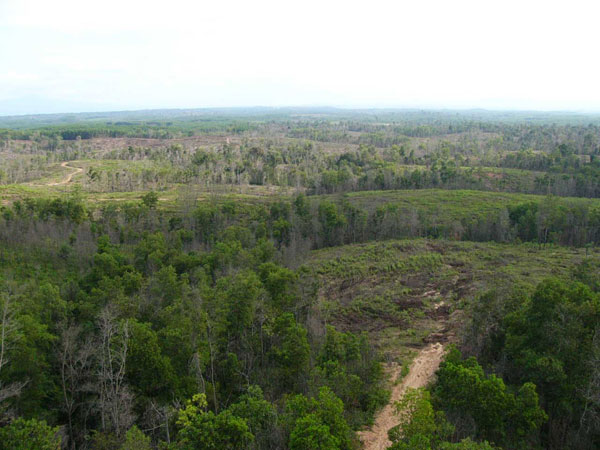
Photo 1. Acacia plantation in Sumatra, Indonesia. Clear-cut in 6 years.
Research Theme for the G-COE Program: KIMURA, Shuhei
My research is concerned with natural disasters as a consequence of long-term interaction between “nature” and “culture” in an area. As an anthropologist, I have been conducting my field research in Istanbul, Turkey, where earthquake risk is a public concern recently, focusing on the activities of local people, municipalities, and academics and the relationships among them. As a member of this G-COE project, I am working with the issue of sustainability in the context of natural disasters, paying attention to local people’s awareness of the risk of disasters and their knowledge concerning disasters, as shaped through everyday life.
My research in detail
Natural disasters constitute one of the most serious risks to a society’s sustainability. Statistical facts have revealed that the number and damage of natural disasters are increasing especially in developing countries, and that the simple application of new technology cannot be a solution. This indicates the importance of a focus on the socio-cultural aspects of a natural disaster. In this context I have been studying natural disasters in Istanbul, Turkey. As is well known, Turkey is prone to earthquakes, and Istanbul, the biggest city in the country with a population of more than ten million, is located on the western part of an active fault line. This North Anatolian Fault Line is said to have generated several earthquakes from east to west sequentially. After a severe earthquake (called the Marmara Earthquake) occurred just east of Istanbul in 1999, it has become a public concern to alleviate the damages of future earthquakes.
Although people’s disaster awareness was raised, Istanbul’s disaster vulnerability has not been reduced easily. Based on my field research, I have illustrated the process of the construction of disaster vulnerability of the city as a historical entanglement of the rapid increase of the urban population, the transformation of national policies related with natural hazards and housing, and the progress of Turkish earth science. In addition to this, I have reported the activities of multiple actors such as local volunteer teams, municipalities, and NGOs, and academics, and the difficulties they are confronted with.
In this G-COE program, I advance my research on natural disaster in the broader framework of Sustainable Humanosphere in collaboration with other members with different academic backgrounds, considering these following intertwined issues. The first point is the relationship between people’s risk awareness and their living environment. People living in the neighborhoods of Istanbul where I have been conducting my field research have lived through a dynamic transition of living environment in their life, that results from the change of network of constructors, construction methods, legal regulations related with housing, and the form of the family. I plan to trace the transformation and examine its effect on people’s risk awareness and social relationships.
The second topic is knowledge communicated among local people. In disaster studies, the notion of “disaster culture”— a system of local and/or traditional knowledge, technologies, practices and institutions to mitigate the damage of disasters— has been under heated discussion recently. I intend to reexamine this idea through research on the narratives of survivors of the Marmara earthquake.
Thirdly, I plan to scrutinize the concept of risk and security. Natural disasters are generally categorized as a risk with low probability and high consequence. Therefore, to take measures against natural disasters in advance can become a point of contention, and in some cases, yet another disaster to some stakeholders. I examine schemes that contribute to a society’s sustainability by shedding light on the administrative mechanisms and frictions related to social risk.
Research Theme for the G-COE Program: WADA, Taizo
I have been engaged in the study of field medicine, especially with regards to the study of geriatrics across the countries of Southeast Asia and also Japan. My colleagues and I have clarified the functional abilities and mental health of the community-dwelling aged in those countries. The concept of the Quality of Life (QOL) could be defined essentially as “human well-being”. However the affects that a person’s cultural and religious background have on the QOL is unclear. My current research interest is concerned with clarifying the universality and diversity of QOL. I also would like to assess the QOL during the end of life and the quality of individual death with dignity from the point of view of practical setting.
Research topics
Over the course of the 20th century, world population increased from 1.7 billion to 6 billion. Meanwhile, population ageing is rapidly growing worldwide, not only in developed countries but also in developing countries. This phenomenon is expected to continue in the 21st century and could be a major threat to sustainable development. Challenges of aging in developing countries are increasing burdens of chronic disease, pensions and income security for older people, not to mention older people who have been “left behind” in the processes of urbanization and modernization with globalization. In order to tackle those challenges, it is essential to conduct interdisciplinary research and this project is such an attempt as outlined below.
Firstly, I would like to evaluate the universality and diversity of quality of life (QOL). In terms of putting forward the research regarding the sustainable development of the humanosphere from the human-nature dynamics standpoint, we should consider what “good life” is. To pursue the meaning of “good life”, the concept of QOL could contribute to promote dialogues in our interdisciplinary research team. However, there are very few reports regarding QOL or mental health in developing countries and its measurement remains fundamentally incomplete.
I have been engaged in the depression screening of older people living in Southeast Asian countries based on the international standard diagnostic criteria which was made by WHO or American Psychiatric Association. Those criteria were developed in Western countries in English and several screening methods were used worldwide. However, its validity in the Asian setting is as yet, unknown. How the cultural and religious background affect the QOL is also unclear, nonetheless the common concept of human well-being might be definable. I would like to develop the scale of QOL or mental health in Southeast Asian countries using an interdisciplinary approach, and to clarify how the meditation practice in Asian countries affects the QOL and the individual death with dignity of older people.
Secondly, Comprehensive Geriatric Assessment (CGA) is to be continued in south-east Asian countries. The World Bank defines the working-age population as the population aged from 15 to 64. But, if the people aged 65 years or older can maintain functional ability and continue their work, they can contribute to economic growth. Lack of information regarding functional ability among older people makes the estimation of economic sustainability difficult. CGA can contribute to the refining of the estimation of an essential “working-age population”. Older people themselves are resources as their knowledge has the potential to generate a new paradigm. If they can continue to work in their society, the essential working population will not decrease rapidly. In that case, sustainable development might be possible. I would like to assess their working ability by evaluating the intellectual activity and social role as well as basic activities of daily living like toileting or bathing using CGA. To clarify the risk factor of such functional ability of older people may open a way to sustainable development in developing countries.
(Related publication)
- Wada T, Matsubayashi K, Okumiya K, Garcia Del Saz E, Kita T: Health status and subjective economic satisfaction in West Papua. Lancet 360:951, 2002
- Wada T, Matsubayashi K, Ishine M, Fujisawa M, Kita T: Depression screening of Japanese community-dwelling elderly people. J Am Geriatr Soc, 51:1328-1329, 2003.
- Wada T, Ishine M, Sakagami T, Okumiya K, Fujisawa M, Murakami S, Otsuka K, Yano S, Kita T, Matsubayashi K: Depression in Japanese community-dwellimg elderly-prevalence and association with ADL and QOL. Arch Gerontol Geriatr 39:13-23, 2004.
- Wada T, Wada C, Ishine M, Okumiya K, Kawakita T, Fushida M, Kita T, Mizuno K, Matsubayashi K: Comprehensive Geriatric Assessment for Community- Dwelling Elderly Asia compared with those in Japan:V West Java in Indonesia. Geriatrics and gerontology International 5:168-175, 2005.
- Wada T, Wada C, Ishine M, Okumiya K, Kawakita T, Fushida M, Kita T, Mizuno K, Matsubayashi K: Comprehensive Geriatric Assessment for Community- Dwelling Elderly Asia compared with those in Japan:VI Maubin in Myanmar. Geriatrics and gerontology International 5: 276-285, 2005.
- Wada T, Ishine M, Sakagami T, Kita T, Okumiya K, Mizuno K, Rambo AT, Matsubayashi K: Depression, activities of daily living, and quality of life of community-dwelling elderly in three Asian countries: Indonesia, Vietnam, and Japan. Arch Gerontol Geriatr 41:271-280, 2005.
- Wada T. Orthostatic hypotension in older people and its association with mortality. London School of Hygiene and Tropical Medicine Library. Master Thesis. No.470343; 1-46, 2007
- Wada T, Ishine M, Ishimoto Y, Hirosaki M, Kimura Y, Kasahara Y, Okumiya Y, Nishinaga M, Otsuka K, Matsubayashi K. Fallers are older and more disabled as well as more depressed than non-faller in the community-dwelling elderly in Japan. J Am Geriatr Soc; 2008 in press.
Research Theme for the G-COE Program: SATO, Takahiro
Time-honored resource utilization systems in each region have been established as sustainable systems encompassing the indigenous environment, society and culture in a historical screening process. Many of the environmental problems faced today by regions with a weak humanosphere arise from the fact that the new values, systems and technologies introduced from the outside during the last several centuries have not been harmonized with the indigenous elements of those regions. In order to find a development path that can be sustainable both globally and locally in regions with such problems, we need to clarify the potential of the indigenous environment of regions and, based on such studies, analyze the problems concerning resource utilization from various perspectives.
The state of Tamil Nadu, situated on the southeastern tip of the Indian subcontinent, is a semiarid area with annual precipitation of around 700-1000 mm in much of its territory. A traditional technology using irrigation ponds was developed long ago in order to utilize local concentrations of rain water as irrigation water in a stable way. However, frequent maintenance work is needed to make possible the utilization of irrigation ponds using overland flow water. One of the factors that led to the establishment of this traditional technology is the existence of a management system called ”kudimaramathu,” based on the village social structure. The land system established during British colonial rule from the 19th century introduced capitalism into the livelihood structure, and the introduction of high-yield varieties and the expansion of cash crops in recent years have led to increasing water demand and the expansion of the use of groundwater. These extrinsic changes have not been harmonized with the scarcity of water resources in the region, leading to a tight water demand situation. Looking further at changes that have the potential to affect the water resources utilization in the region in the future, we can cite changes in precipitation caused by global warming and the expansion of acreage dedicated to energy crops. What kind of approach will be required to construct a sustainable humanosphere development path for this region?
First, more than 50% of the population of the region is engaged in agriculture in one form or another, so it can be said that the key to sustainable development lies in the water resources. However, since the water circulation structure of the catchment area that forms the basis for the preservation of the water circulation/management has yet to be elucidated, we cannot state with certainty that systematic water utilization is being carried out. In order to find a sustainable humanosphere development path for the region, data concerning the water circulation structure and water resources utilization must be collected and analyzed and the potential agricultural productivity of the water environment of the region must be elucidated. I will construct a “humanosphere data base” made up of a thematic map produced based on observational and statistical data, and elucidate, from a natural science perspective, the characteristics of the water resources that form the livelihood basis of the region.
Following that, with the aim to formulate a proposal on necessary technology and systems, I will conduct a simulation using an artificial society. I will identify the actors involved in the sustainability of water resources based on field interviews and elucidate the relationship between the actors semi-quantitatively. I will then describe the structure of water utilization of the region as an agent model and list the factors that affect the region’s water utilization, such as forecasts of changes in the climate under a global climate model and demographic changes, as a scenario for environmental change. I will analyze the process of change in the artificial society in accordance with the scenario of environmental change and examine what interventions are necessary to prevent system failure.
As stated above, I would like to produce a paradigm for a sustainable humanosphere through an area informatics approach through the construction and analysis of a humanosphere data base and a simulation of an artificial society.
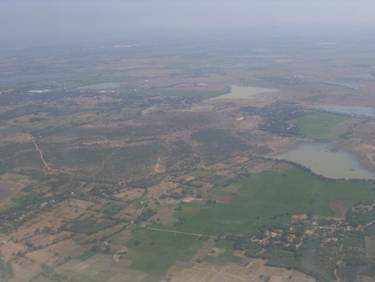
Photograph 1: Aerial view of irrigation ponds
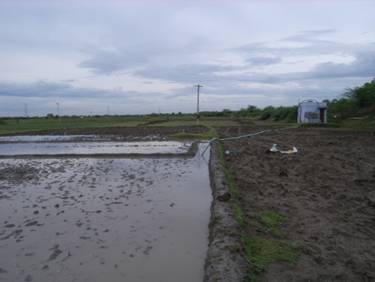
Photograph 2: Groundwater utilization in an area benefiting from an irrigation pond
Research Theme for the G-COE Program: NISHI, Makoto
Content of studies conducted so far
Based on my fieldwork in Ethiopia, I have been studying the relationship between the formation of ethnicity and the state system and have conducted studies concerning the activities of resident organizations in that country.
As a study concerning the activities of resident organizations, I took up the case of the Gurage Roads Construction Organization in Ethiopia and conducted a critical examination of the debate concerning social development in modern Africa. In traditional development studies, there has been a debate between those who see democratic practice as realized through the method of so-called resident participation and opponents who see the discourse of “participation” as just a means to force the will of the government and aid organizations upon the residents. Both of these positions, however, are based on the premise that the government and aid organizations are the principal actors of development. In opposition to this, partly based on Nancy Fraser’s theory of counter public sphere and other theories, I have tried to present the possibility of the public acting as a counter to social exclusion and repression, by looking at the development practice led by local residents in Ethiopia.
The Gurage Roads Construction Organization is a resident organization established in Ethiopia in 1962 by people relocated from villages in Gurage Province in the southern part of the country to the capital of Addis Ababa (Gurage emigrants), with the aim to build roads and schools in their home villages. At the time, villages in the southern part of Ethiopia were subject to an exploitative system of large land holdings connected with the aristocracy. The aristocrats, who were mainly from the northern part of the country, occupied high positions in the central and local governments. On the other hand, many farmers in Gurage Province were landless tenant farmers. Under this situation, the activities of the Gurage Roads Construction Organization can be understood as an early attempt to form a system of redistribution from cities to rural villages.
A peculiar feature of the organization is the cooperation carried out with the funeral mutual aid association. Funeral associations are the most popular form of resident organization in Ethiopia, which were originally set up for the mutual provision of money and labor necessary for funerals. The immigrants from Gurage living in cities also formed their own funeral associations, which have a clear membership and a system to collect membership fees. Through cooperation with the funeral associations organized by Gurage immigrants, the Gurage Roads Construction Organization acquired the means to obtain support for its activities from a wide range of residents and regularly collect funds for its activities.
The case of the Gurage Roads Construction Organization shows that the activities of resident organizations can create a counter social relationship under a social system (the Ethiopian aristocracy in the 1960s) where the interests of some groups were structural excluded in order to allow a specific group to obtain benefits. Its activities can be seen as achieving broad support and sustainability by being connected with the local knowledge rooted in people’s lives, as can be seen in its cooperation with funeral associations.
Future studies
Within the framework of the GCOE program, I hope to contribute to the formation of studies on the sustainable humanosphere paradigm centering around the area of “studies on local knowledge and indigenous wisdom.” My task from now on will be to discuss the process of how people living in a local community, while attempting to respond to risks such as infectious diseases that threaten their humanosphere, reconstruct the local knowledge and create new social relationships.
Concretely, I plan to investigate the issue of HIV/AIDS. In Africa, HIV/AIDS is considered as a serious risk to the sustainability of local communities. While viruses that cause infection have to be stopped from spreading through proper preventive measures, such actions can lead to social exclusion of people who are infected (people living with viruses). For those who are infected, this difference in position compared to the non-infected becomes a risk to their own lives.
In this study, by analyzing the activities of conventional political organizations and resident organizations in Gurage Province, Ethiopia, I will plan to investigate, in relation to the risk of infectious disease that threatens the sustainability of the social life of the local community, how residents themselves, those directly concerned, interpret such social risks. At the same time, I plan to elucidate the type of communication channel that they are using to overcome the conflicts and frictions that arise between infected and non-infected people and construct a durable social relationship where they can coexist at the local community level. More concretely, I plan to investigate the activities of resident organizations that prompt solidarity between the infected and non-infected, as well as cases where care for the infected is being carried out based on local customary law.
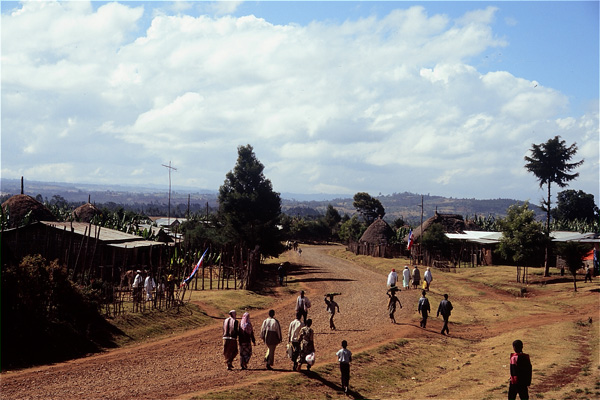
Photograph: Road constructed with funding from the Gurage Roads Construction Organization
Research Theme for the G-COE program: Tamaki Endo
Content of studies conducted so far
I have been studying the growth and development of cities in South East Asia, mainly in Thailand, from the perspective of development economics and regional economics. In the background of this interest is the fact that the explosive growth of cities in developing countries cannot be understood with the traditional theoretical framework that is used to analyze the growth of cities in the West, and that urban analysis based on the single-track theory of modernization/growth of early-stage development economics for developing countries fails to grasp the increasingly multi-layered nature of urban dynamism. In order to go beyond this, I have actively adopted the perspective of area studies, using both macro analysis (empirical and policy study) and micro-level empirical studies using long-term field studies, and have performed dynamic analysis of cities in developing countries in the age of globalization, and in particular theoretical and empirical studies of the informal economy.
In the area of policy analysis, I have analyzed the emergence and transformation of policies on urban poverty and support policies for the informal economy in Thailand, together with their politico-economic backgrounds. The failure of support policies to keep up with the reality of multi-faceted cities and urban lower classes is becoming increasingly clear.
In terms of empirical studies and situation analysis, I have adopted a dynamic perspective, focusing on the dynamism of the informal economy and the labor and livelihoods of the urban lower classes.
Finally, from a macro perspective, I have analyzed the reorganization of the economic structure (industrial structure and labor markets) and urban space using various macro statistics, materials and geographical materials, and have looked empirically at the economic and spatial structure of the city. I have analyzed the effects of the reorganization of the global economy and labor since the latter half of the 1980s on the “labor” and “livelihoods” of urban lower class people and their response to it, mainly from the aspects of “occupation” and “dwelling.” It has become apparent that changes in the occupation and dwelling patterns of urban lower class people are linked to the dynamism of the cities, and that a stratification has taken place within the urban lower classes along with this dynamism.
Future studies
It was quite some time ago that people began to proclaim that “the 21st century will be a century of cities.” According to the UN Population Fund, the urban population, which accounted for only one tenth or so of the world’s population in 1900, is expected to top 3.3 billion, making up more than half of the world population, by the end of 2008. Moreover, it is expected that by 2030, about 80% of the world’s urban population will be concentrated in developing regions and that the large Asian cities will account for a half of the large cities of the world. In the Asian region, however, perhaps due to the diversity, there is a tremendous lack of urban studies compared to the enormous accumulation made in rural studies, even though the importance of urban studies has been pointed out. The ongoing process of rapid globalization and urbanization, however, has posed various problems not just for Asia but for the entire world. Therefore, in considering a global sustainable development paradigm, cities are an important theme that cannot be overlooked. By further developing studies on the cities and informal economy of Asia, in particular South East Asia, I plan to participate in the empirical study of the history, present situation, and future prospects of the sustainable humanosphere path and, ultimately, to present a way of sustainable development for cities in Asia which is different from the Western type, taking into consideration the relationship with other regions.
Research Theme for the G-COE Program: UBUKATA, Fumikazu
It is said that modern society is a “risk society.” This expression is used in the sense that modern industrial society produces and distributes not only wealth but also risks produced by industrialization.
Needless to say, environmental problems are an important part of these risks. Since environmental protection and environmental science were born in the West, they seem to conceal within themselves western ideas tinted with the theory of stages of economic growth, such as the environment as a superior good, privatization and nationalization of resources, or the environmental Kuznets curve. Because these were adopted unchanged in Asia and other spheres of civilization that differ from the West, mainly through state systems, they led to serious conflict between the state and local communities.
Historically, people in this region have adopted survival strategies to disperse various risks such as natural disasters and epidemics through individual lifestyles and the features of “communal sphere” such as communities and commons. Ensuring peoples’ livelihood was regarded as top priority in these societies, and consequently the environment (and “humanosphere”) should also be sustained in order to ensure the life of dependent people.
Many of the contradictions and conflicts that later arose in these societies were tragic by themselves. However, if we change our perspective, they can also be seen as opportunities for encouraging a “sustainable humanosphere” type of social development. In recent years, the concept of “ecological modernization” has been promoted by environmental sociologists in the West. They do not see the environmental disruption due to modernization and globalization as something that is necessarily inevitable. Rather, they take the position that modern social conditions make it possible to change the behavior of companies, consumers and governments and to build a society with a high level of environmental governance.
It cannot be denied that to a large extent, this concept at present is based on the Western context. In contrast, however, would it not be possible to postulate an “ecological modernization” that is of a different type, based on the traditional “sustainable humanosphere” society of the Asian region, with a historical background that is different from that of the West? Keeping this question in mind, I would like to use the following two studies (corresponding to the production and conservation of resources), along the lines of the research that I have conducted, as case studies, to investigate, in an interdisciplinary manner, how the behavioral principles and relationships between actors at the global, national, and local levels in the Asian region affect the formation and outcomes of systems related to environmental governance, how it might be possible for these systems to coexist with modern global society, and how the non-region-specific universality and specificity of the region interact in this series of processes.
Toward “ecological modernization” in forestry and related industries
While large-scale plantation forestry operated by companies has brought forth various social and environmental problems, a system of material procurement based on agricultural family forestry, which has fewer ill effects, has been adopted in the pulp industry in Thailand since the 1990s. I have been studying this transformation from the perspective of political economics and, focusing on the technical and geographical features related to forestry and the industry and trends among the actors such as the state, companies, and residents. In future studies, I would like to apply this perspective to Indonesia and compare the two systems by analyzing how the full-scale introduction of such a system has been hampered in Sumatra’s pulp industry and why the opposition movement there has not led to a system change reflecting the wishes of the residents. In doing so, I will describe the divergence of paths toward “ecological modernization” from a variety angles. I also plan to analyze the situation concerning rubber plantations and forestry in formerly cultivated areas of Laos and the southern area of China from the same perspective.
Community-based natural resource management and environmental governance
In recent years, there have been many attempts in the developing countries to adopt community-based natural resource management (CBNRM) to preserve and regenerate resources by transferring usufruct rights for natural resources to local residents. This trend is becoming increasingly rooted due to the trend toward administrative decentralization. I have been studying the process of establishment of a local CBNRM system in one region in Thailand. However, since the relative importance of CBNRM in the overall resource conservation policy and its efficacy in relation to actual environmental governance differ greatly depending on the country and region, there is a need for a more macro oriented perspective. Therefore, I plan to look at the actual cases of forestry preservation policies of Thailand, Laos, the Philippines, and Indonesia, whose resources differ in total amount and relative importance in the domestic economy, and analyze from different angles how various actors have been involved in the CBNRM policymaking process and reflected in the local reality/systems, and thus elucidate the patterns of paths toward “ecological modernization” followed by each of them.
Through these studies, I will examine “ecological modernization” from a comparative perspective and at the same time construct a framework that transcends the “simple dualism of the state and local community, industry and livelihood, and production and conservation” that is the mainstream view when discussing the environment and society in Asia.
